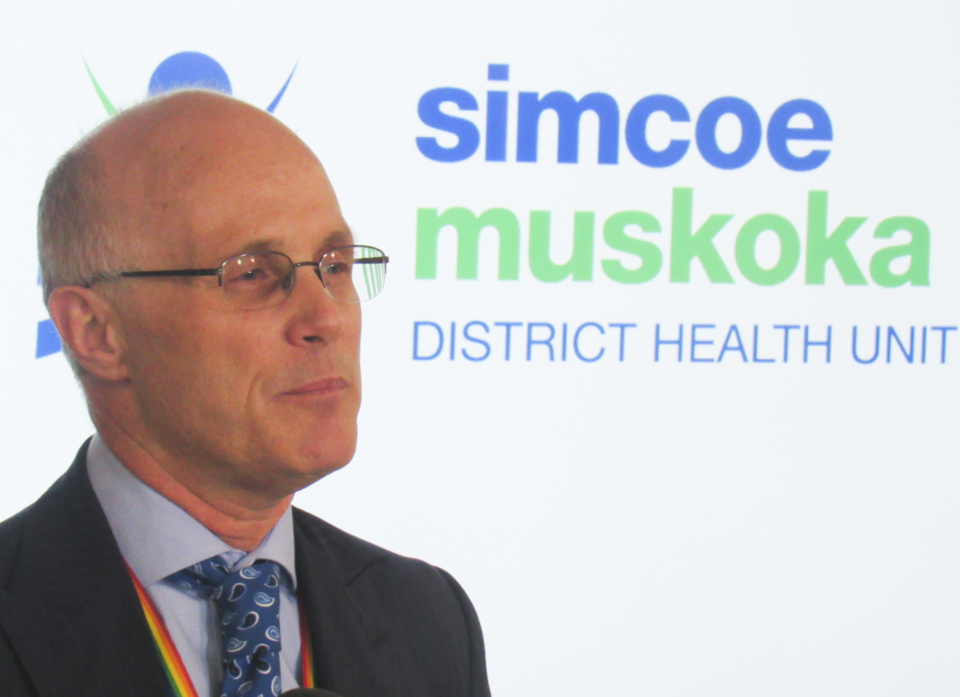The region’s top doctor says there are more COVID-19 cases than are reported, and hospitals won’t be able to test them all.
So far, the Simcoe Muskoka District Health Unit has reported 10 lab-confirmed COVID-19 cases, but the health unit’s medical officer of health, Dr. Charles Gardner, said there are definitely more than that in the region.
“It’s certainly clear to me there are more cases than the 10,” said Gardner, adding there are always more cases of an outbreak illness than get confirmed in a lab. “There’s always this tip of the iceberg phenomenon with surveillance.”
He further elaborated based on past influenza outbreaks, there can be as many as 10 times the number of infections that are reported from lab testing.
The health unit applied a University of Toronto-built modelling system to the region, and it predicted the infection rate for Simcoe Muskoka could reach 50 per cent of residents.
“We need to act now with our public health measures, and do what we can do blunt transmissions so we don’t get this big surge,” said Gardner.
He said a large surge in patients who are ill and have complications will be difficult for local hospitals and healthcare providers to handle.
“Our case survival rates will be much better if we can avoid a big surge,” he said. “It’s important people everywhere in the province assume it’s coming.”
“We’ve had three cases that I’ve characterized as community-acquired, that is, not linked to travel,” said Gardner. “It really speaks to the importance of people in our community being aware it is being spread in the community.”
And the evidence of community spread is a small picture of what is happening. Currently, only individuals who are showing symptoms and have travelled or been in contact with someone who has travelled are getting tested. Sometimes, not even then.
Those showing severe symptoms can also be tested regardless of history. That’s the reason the health unit discovered a case in a Bradford woman in her 30s with no history of travel or close contact with a known case. She was hospitalized for her symptoms.
“We’re aware of the community cases because they’re severe cases,” said Gardner.
There’s also a lag in test results; some are taking seven days to come back from the lab. Gardner said in some cases where a case is “suspicious” or very probable the health unit will follow up with known contacts before the test result comes back.
However, in other cases, the health unit is waiting for test results to come back positive before reaching out to known close contacts about possible exposure.
Those contacts are not always tested, and in many cases are told to self-isolate out of precaution.
“As this transmits in the community, we will get to the point where there are potentially many others in the community who won’t have an obvious link, and we won’t be able to test them all,” said Gardner.
His advice to everyone: know it’s out there and stay home.
“Consider once or twice, do you really need to go out? If you do, you need to be exercising social distancing,” he said.
Even if people believe they have the virus and are exhibiting symptoms, Gardner said they should also stay home and not leave to get tested. Assume you have it, and self-isolate for 14 days or 24 hours after symptoms go away, he said.
To those communities and governments that have not yet declared a state of emergency, Gardner urged the window is closing.
“Now is the time to be considering such an action,” he said.
The health unit announced today it will no longer be releasing case details such as what community each positive COVID-19 case was discovered in. Instead, the unit will be reporting numbers and focusing on the “take-home” message for residents in the region.
Such messages include urging the public to self-isolate, to avoid public gatherings and to stay two meters away from anyone who doesn’t live at home with you.
“Clearly, there is much more that can be done if it needs to be done,” said Gardner, referring to strict, enforced lockdowns in Germany and Italy. “My message would be, let’s do all we can now with what we have no to avoid having to go there.”



